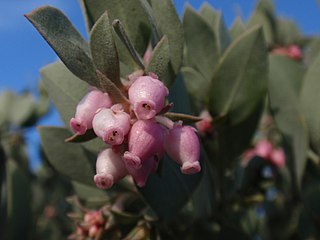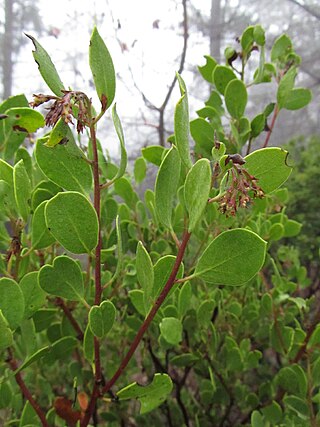
Arctostaphylos catalinae, known by the common name Santa Catalina Island manzanita, is a species of manzanita native to Southern California. The evergreen shrub is found growing naturally only on Catalina and Santa Cruz Islands on the coast ridges. It thrives in maritime chaparral and can be used in coastal gardens.

Arctostaphylos confertiflora is a rare species of manzanita known by the common name Santa Rosa Island manzanita. This shrub is endemic to California, where it grows on the sandstone bluffs of Santa Rosa Island in the Channel Islands. This manzanita is listed as an endangered species by the United States Government.

Arctostaphylos columbiana is a species of manzanita known by the common name hairy manzanita. It is native to the coast of western North America from northern California to southwestern British Columbia. This large manzanita is a shrub or small tree, usually 1–5 meters tall. It is erect with hairy branches. The leaves are oval-shaped and are usually 2-6 centimeters long and 2-3 wide, pale bluish green, fuzzy on both surfaces, occasionally glandular. The small, white, urn-shaped flowers are borne in bunched inflorescences. The fruit is a red drupe about a centimeter in diameter. The seed requires either fire or consumption by animals in order for germination to occur. This manzanita grows in open, rocky areas. It is sometimes grown as a garden ornamental. Hybrids with Arctostaphylos uva-ursi commonly occur where the two parent species grow in proximity.

Arctostaphylos nummularia is a species of manzanita known by the common names glossyleaf manzanita, dwarf manzanita and Fort Bragg manzanita. It is endemic to California, where it grows in the forests of the coastal and inland ranges north of the San Francisco Bay.

Arctostaphylos bakeri is a species of manzanita known by the common name Baker's manzanita. It is endemic to Sonoma County, California, where it grows in the chaparral and woodlands of the North Coast Ranges. It is sometimes a member of the serpentine soils flora.

Arctostaphylos canescens, common name hoary manzanita, is a species of manzanita.

Arctostaphylos densiflora, known by the common name Vine Hill manzanita, is a very rare species of manzanita. It is endemic to Sonoma County, California, where it is known from only one extant population of 20 to 30 individual plants. These last wild members of the species are on land near Sebastopol which is owned and protected by the California Native Plant Society. In addition, there are five to ten plants of this manzanita taxon growing on private property about a mile away. The local habitat is mostly chaparral on sandy shale soils.

Arctostaphylos imbricata is a species of manzanita known by the common name San Bruno Mountain manzanita.
Arctostaphylos malloryi is a species of manzanita known by the common name Mallory's manzanita. It is endemic to California.

Arctostaphylos myrtifolia is a rare species of manzanita known by the common name Ione manzanita. It is endemic to the Sierra Nevada foothills of California. It grows in the chaparral and woodland plant community on a distinctive acidic soil series, an oxisol of the Eocene-era Ione Formation, in western Amador and northern Calaveras counties. There are only eleven occurrences, of which three have not been recorded since 1976. This is a federally listed threatened species.

Arctostaphylos nissenana is a species of manzanita known by the common name Nissenana manzanita or El Dorado manzanita. It is endemic to California, where it grows in the woodlands and chaparral of the Sierra Nevada foothills, mostly in El Dorado County.

Arctostaphylos obispoensis is a species of manzanita, known by the common names bishop manzanita and serpentine manzanita, endemic to California.

Arctostaphylos osoensis is a species of manzanita known by the common name Oso manzanita. It is endemic to San Luis Obispo County, California, where it is known from only two occurrences on the northern edge of the Los Osos Valley. It grows exclusively on volcanic dacite from the Morro Rock-Islay Hill Complex associated with the Nine Sisters.

Arctostaphylos pajaroensis is a species of manzanita known by the common name Pajaro manzanita. It is endemic to California, where it is known mainly from Monterey County.

Arctostaphylos pilosula is a species of manzanita, known by the common names La Panza manzanita and Santa Margarita manzanita, that is endemic to California.

Arctostaphylos virgata is a species of manzanita known by the common names Bolinas manzanita and Marin manzanita.

Arctostaphylos rainbowensis is a species of manzanita known by the common name Rainbow manzanita. It is endemic to California, where it is known only from northern San Diego and southern Riverside Counties in the Peninsular Ranges.

Arctostaphylos gabilanensis is a rare species of manzanita known by the common name Gabilan manzanita.

Arctostaphylos ohloneana is a rare species of manzanita known by the common name Ohlone manzanita in the Santa Cruz Mountains in California. It is endemic to northwest Santa Cruz County, where it is known only from four populations on Ben Lomond Mountain, just south of Big Basin Redwoods State Park.

Arctostaphylos nipumu, the Nipomo Mesa manzanita or nipumu manzanita, is a species of manzanita endemic to Nipomo Mesa in San Luis Obispo County, California. It was formerly considered to be the northernmost population of Arctostaphylos rudis, a rare manzanita primarily found near Lompoc. It is highly threatened by development, with only an estimated 300–700 plants in the wild at the time it was described.




















